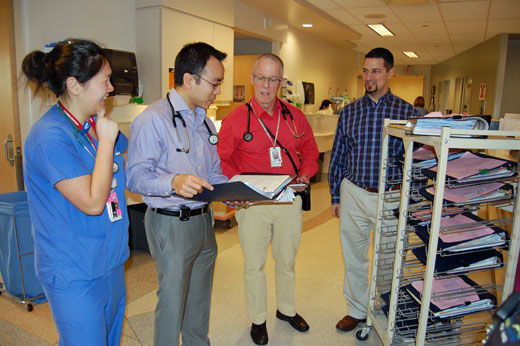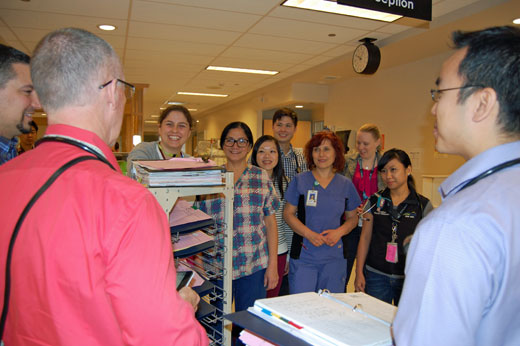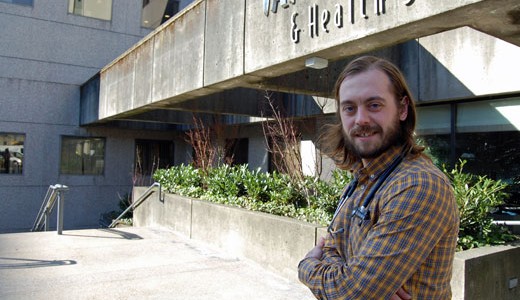No more life on the run
It wasn’t the life of a fugitive, but it certainly felt like life on the run.
“My record was 24 patients on 14 different floors in both the JP and Centennial Pavilions,” says Dr. Iain Mackie, interim medical director, CTU. “We used to spend a lot of time in transit. It was incredibly inefficient.”
Not anymore.
Thanks to aredesign, VGH Clinical Teaching Unit (CTU) physicians are spending less time on the run, treating patients in multiple locations, and more time on patient care. Today, most CTU teams have a defined home base, an assigned medicine unit where medical students, interns, Residents and Attending Physicians provide care for nearly all the patients on that unit. Another team is dedicated to the Emergency Department.
In just one month the new model is making a positive difference for patients, hospital staff and our CTU teams.
More time with patients

Enhanced patient care meets enhanced learning (left to right): Cassandra Ma, Dr. Dan Lee, Dr. Iain Mackie and Gerry Desilets during rounds on the Acute Medicine Unit at VGH.
With a home base, physicians have more time to develop relationships with their patients and meet with families on a regular basis.
“A patient with stomach cancer was admitted to my own ward just the other week,” says Iain. “We were able to meet with the family on their time schedule, not ours — no setting up meeting times, no phoning to find out where we were. We were right there to help the family through this difficult time.”
The immediate availability of the CTU team is particularly striking where there are step-down units, adds Iain. “We’re right there when problems arise, and we can intervene immediately, when needed.”
Enhanced educational experience
From a learning perspective, Iain says the new model has “enhanced our ability to do daily teaching.”
Dr. Chris Little, a senior Resident, agrees. “As a team we’re more involved in patients’ everyday care and there’s value in following a patient’s progress from arrival to discharge.”
An unexpected bonus, says Iain, is the CTU’s interaction with consulting services. “In the old system we would have never seen them, or only seen them coincidentally. Now they can review patients with us and, more importantly, teach by reviewing cases with us.”
More collaboration and teamwork

More rounding as a team (facing left to right): Katherine Zavaglia, Marilou Barbosa, Erina Chan, Ken Little, Sandra Hold, Carla Metz and Jenifer Tabamo.
Ask Lara Pollard, patient care coordinator, what bedside staff think and she’s quick to respond. “The nursing and allied staff are loving it! There’s more of a team approach,” she explains. “We have a better understanding of what each other is doing and accomplishing.”
Before the new model, it was a challenge for physicians to attend daily iCARE rounds. Today, Lara says attendance is regular and “now there’s much more collaboration to plan a safe and timely discharge.”
The results speak for themselves. Take the Acute Medicine unit where 24 more patients than predicted (based on past experience) have returned home — and that’s in less than one month.
A work in progress
Over the past month, adjustments have been made to address issues, including improving continuity of care. Today, the physician who initially sees the patient in the ED continues as the patient’s Attending Physician 75% of the time — meeting the CTU target.
“Everyone wants the system to work,” says Iain. “It has been an eye opener for me to see everyone pull together — quite incredible.”
Still, Iain isn’t satisfied to stop here. There’s more work to do and priorities include improving patient information handovers between physicians, developing a Parallel Internal Medicine Services team to care for patients during peak volumes and standardizing the CTU educational experience across the hospital.
“We’ll continue working to make the model more effective and efficient because, to me, our patients will be the biggest beneficiaries.”

